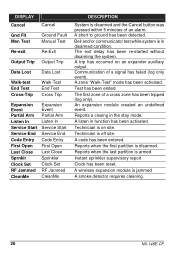

Unfortunately, I have no attic access above any of the smoke detectors to be able to see if any of wiring is just sitting above the gang boxes. The reason I thought the cat5 wiring was a part of the smoke detectors in the first place, was because the "Smoke Alarm" terminals on the panel do not have anything hooked up and that cluster of 5 cat5 wires are not hooked up to anything but themselves. But its easier when you have the terminating resistors in the panel.īTW with all of the Cat5 in the panel you might be able to juggle a zone and utilize one cable for your network into the panel wiring. All of the documentation I read mostly saids to put terminating resistors at the distal side of the zone so I did it that way. I have seen though the same you have with the terminations at the panel. My old old beta test panel had something like 48 zones with build in X10 from the late 1980's. I think though the older panels only had a few zones rather than say an OPII with a base of 16 zones and ease of adding more zones.
NETWORX ALARM SYSTEM RESET WINDOWS
Some folks prefer though to put all of the windows in one room to one zone.

All of the windows are in their own zone too. The PIRs are also in separate zones along with each door that opens out. In Florida I have like 4 sliding glass doors and each one has four NC/NO switches looped to one zone (IE 4 zones one per sliding glass door). For me though its one pair/two pair of wires per zone per device with no loops in the midwest. I have my two OPII panels terminated at the distal sides of the zones. Personally I have seen two "camps" relating to terminations with resistors. The blue and white cables maybe daisy chained loops or zones (IE: windows and doors for one room being one zone looped in the panel?) The "off white" cables appear to be definitely cat5 (or cat5e) wires with 4 pairs (8 wires) and the white ones definitely appear to be 2 pair (4 wires). You could also label them one by one which would help you with your endeavor. You could do this with just a VOM and some alligator clips. The time consuming pieces really were just tracing the wiring and replacing a bunch of NC/NO switches and checking on the terminations (new resistors). The actual wiring pieces to the OPII panel only took maybe one hour or less connecting each zone one by one and using PCA to validate each zone. It took me two days all day to do the wiring for the neighbors HAI panel. A bit time consuming but it will be worth your efforts. If the panel is not being utilized right now for anything then I would trace each of the wires one by one.
NETWORX ALARM SYSTEM RESET CODE
I never assumed that the smokes LV wiring would have been in the boxes above the smokes as that is a really not to any code that I know of but maybe sitting loose above the boxes somewheres and maybe labeled? Or they could be just sitting in a bundle above the alarm panel in the attic. The 2 pair (4 wires) look to be of a thicker guage same though guage as the cat5e wiring. Looks like the wiring guy mixed all of it together (smokes too?). The blue and white wires could be loops related to zones. It does not appear to be plenum rated from what I can tell. Looking at your picture the cat5e appears to be of the older type with easier to see colored wires. It was really a bit of a fire hazard and it didn't make sense to me other than maybe it was done on the "cheap", non qualified installer and quickly? I put an electrical box in the wall redoing the HV wiring such that it went into the wall and into the box.

The installer had literally pulled electric down from the attic leaving the bare wires and wrapping them around the terminals of the alarm panel transformer then putting black tape on this setup. Thing that really bugged me was it was really a mickey mouse set up. I redid the roomed loops and ended up with about 6 zones. I removed and disconnected all of the cabling tracing each wire one by one back to the panel. That said I noticed that the wiring loops were done in the rooms in the ranch style home.
NETWORX ALARM SYSTEM RESET PRO
I helped a neighbor in Florida replacing and installing a new Omni Pro II replacing their legacy panel a few years back.


 0 kommentar(er)
0 kommentar(er)
